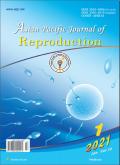Sperm DNA fragmentation does not affect the clinical outcomes in the cumulative transfers of an ICSI cycle along with blastocyst transfers in couples with normozoospermic male patients
IF 0.6
Q4 REPRODUCTIVE BIOLOGY
引用次数: 0
Abstract
Objective: To know whether sperm DNA fragmentation (SDF) affects the clinical outcomes in the cumulative transfers of an intracytoplasmic sperm injection (ICSI) cycle along with blastocyst transfers in couples with normozoospermic males. Methods: The study included 252 couples who underwent their first ICSI cycles along with blastocyst transfer and whose male partner semen samples were normozoospermic according to the World Health Organization 2010 criteria. All the couples were classified into two groups based on the SDF: the low SDF group (SDF≤30%, n=162) and the high SDF group (SDF>30%, n=90). Clinical as well as laboratory outcomes were correlated between the two groups. Sperm DNA fragmentation was assessed on the post-wash semen samples by acridine orange test. The main outcome measures were the live birth rate and miscarriage rate. Results: A significant decrease in the live birth rates was observed in the high SDF group compared to the low SDF group in fresh embryo transfer cycles (P<0.05). However, no significant difference was observed in the clinical outcomes either in the frozen embryo transfer cycles or in the overall cumulative transfer cycles (P>0.05). No significant difference was observed in the laboratory outcomes between the two SDF groups. A remarkable decrease in sperm motility was observed in the high SDF group compared to the low SDF group (P<0.05). Conclusions: Sperm DNA fragmentation does not affect the clinical outcomes in the cumulative transfers of an ICSI cycle along with blastocyst transfers in couples with normozoospermic males.精子DNA断裂不会影响正常精子男性患者夫妇ICSI周期累积转移和胚泡转移的临床结果
目的:了解精子DNA片段化(SDF)是否会影响精子卵母细胞内单精子注射(ICSI)周期累积转移和胚泡转移的临床结果。方法:根据世界卫生组织2010年的标准,这项研究包括252对夫妇,他们接受了第一次ICSI周期和胚泡移植,并且他们的男性伴侣精液样本是正常精子。根据SDF将所有夫妇分为两组:低SDF组(SDF≤30%,n=162)和高SDF组(SDF>30%,n=90)。两组患者的临床和实验室结果是相关的。通过吖啶橙试验对洗涤后精液样本的精子DNA片段进行评估。主要观察指标为活产率和流产率。结果:在新鲜胚胎移植周期中,高SDF组的活产率显著低于低SDF组(P0.05)。两组的实验室结果无显著差异。与低SDF组相比,高SDF组的精子活力显著下降(P<0.05)。结论:精子DNA断裂不会影响正常精子雄性夫妇ICSI周期累积转移和胚泡转移的临床结果。
本文章由计算机程序翻译,如有差异,请以英文原文为准。
求助全文
约1分钟内获得全文
求助全文
来源期刊

Asian Pacific Journal of Reproduction
Veterinary-Veterinary (all)
CiteScore
1.70
自引率
0.00%
发文量
588
审稿时长
9 weeks
期刊介绍:
The journal will cover technical and clinical studies related to health, ethical and social issues in field of Gynecology and Obstetrics. Articles with clinical interest and implications will be given preference.
 求助内容:
求助内容: 应助结果提醒方式:
应助结果提醒方式:


